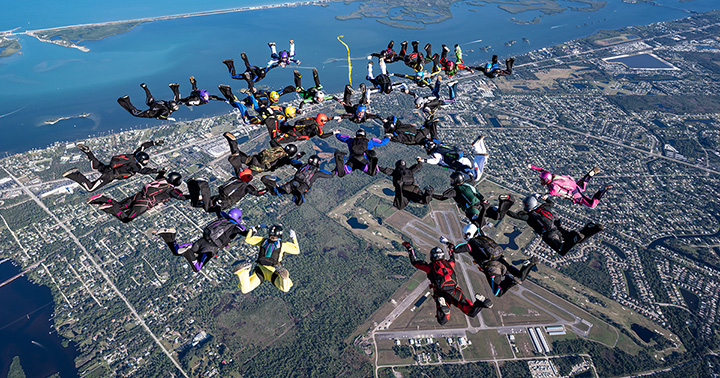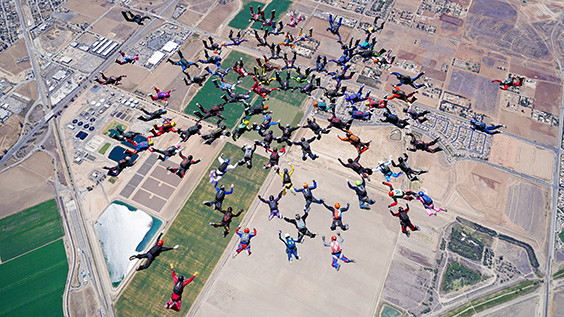Above: Photo by Elliot Byrd.
In our previous article titled “Exit Fundamentals for New Big-Way Jumpers” (Parachutist, August 2024), we discussed how to improve exits and how to dive (or float) with awareness and control to a designated location in the stadium setup. This article provides techniques to help jumpers finish the job of getting to the formation, including how to inch their way down to their slots, avoid traffic, dock smoothly and help fly the formation.
Flying in a big-way is quite different from turning points in a 4- or 8-way. It’s not necessarily harder, but it requires a lot of discipline and patience as you wait for the formation to build. It also requires an ability to multitask. As you move down to the formation, you have to simultaneously control your fall rate, keep an eye out for the formation moving around and look out for jumpers who might cut you off. Obviously, multitasking is not limited to big-ways; other disciplines require it as well. But on big-ways, there are more jumpers in the sky and, therefore, a few more things to deal with so that everybody can enjoy a safe and successful skydive.

"As soon as you are on grips, look across the formation and fly level with the other side, adjusting your fall rate as needed." Photo by Elliot Byrd.
Terminology
Quadrant
One-fourth of the completed formation.
Radial
Think of your radial as an imaginary line extending from the center of the formation through your slot and all the way out to your location in the stadium setup. Staying on your radial makes colliding with another jumper less likely.
Stadium Setup
An approach to the formation where jumpers set up above and outside their quadrants and then work their way down to their slots.
For a more detailed explanation of “Quadrant” and “Stadium Setup,” see “Exit Fundamentals for New Big-Way Jumpers” in the August 2024 Parachutist.
Joining the Formation
The Importance of Stopping
You must be completely stopped when you reach your location in the stadium setup. This helps you control your momentum, so you don’t fly past jumpers who are supposed to dock ahead of you, causing confusion and possibly a collision or funnel. (Tip: When coming out of a dive, it takes longer to bleed off your speed, so put on the brakes early.) Being completely stopped also forces patience, giving you time to line up on your radial and identify the jumpers you will be docking on.
Inch Your Way Down
Once you are lined up in the stadium setup, you can start inching your way down to your slot, staying a few feet above and behind the jumpers you will be docking on, but not so close that you would run into them if they slowed their descent or suddenly stopped. It’s like moving down to take the seat in the imaginary stadium that they have just vacated, as they do the same for jumpers ahead of them. Repeat this process until the jumpers ahead of you have docked and your slot is ready for you to move into.
Move In and Dock
As the jumpers you will be docking on are taking grips, stop a foot or so above your slot. Then, when the formation is flying level and stable, finish your descent into your slot, staying a few inches above for good measure until you are sure that you can fly level and take grips without sinking out or floating. Then—and only then—look briefly at your grips and take them without tension in your arms.
Help Fly the Formation
As soon as you are on grips, look across the formation and fly level with the other side, adjusting your fall rate as needed without hanging on grips or floating in your slot. Don’t be the person who drags the formation down, makes it float or contributes to “potato chipping,” where it undulates like a blanket when you shake it to spread it over your bed.

"The formation will shift, 'breathe' and change fall rate, and you will have to react quickly." Photo by Yuliya Katuyeva.
But what if … ?
Assuming you have done everything right, things can still happen that are out of your control. It would be impossible to describe them all, but here are a couple very important ones.
What if the formation moves or changes fall rate?
This is where your flying skills need to be at their sharpest. You must be able to adjust your fall rate and move pretty much in any direction in order to maintain your position on your radial. Because the formation will shift, “breathe” and change fall rate, you will have to react quickly—but not erratically—to these changes. Again, you must be able to multitask by taking corrective action without losing focus on the formation.
What if somebody bumps into me?
If another jumper slides over and bumps into you, hold your position, meaning don’t go limp and let yourself get pushed around. Stiffen the part of your body being bumped. Sometimes you might need to nudge the jumper away from you if it seems likely that he will knock you off your path or funnel the formation. Holding your position, though, is usually the best defense.
Fall-Rate Adjustment
If you find it too difficult to adjust your fall rate, you will either need to wear more weights (if you float) or a baggier jumpsuit (if you fall too fast). Typically, wearing weights takes care of your floating issues. Obviously, there is a limit on the amount of weight you can safely wear and still fly effectively and not overload your canopy. If you are a faster faller, there might also be limits on how baggy your jumpsuit can be and still allow you to fly effectively. If wearing a baggier jumpsuit doesn’t help with your fall rate issues, ask to be moved up closer to the base. There is no shame in asking to be moved. In fact, you will be better able to showcase your flying skills when you don’t have to struggle to stay with the formation. It will also prove that you are a team player.

"When coming out of a dive, it takes longer to bleed off your speed, so put on the brakes early. Photo by Kristian Caulder.
Sharpening Your Flying Skills
You don’t need to be on a big-way jump to improve those big-way flying skills. On small formations, practice things like stadium approaches, staying on your radial and flying level in your slot before taking grips. These skills are necessary regardless of the size of the formation. It also helps if you can participate in skydives with load organizers who provide video debriefs. And, obviously, one of the best ways to improve your skills is to attend a big-way camp.
But you can also reinforce your flying skills when you can’t skydive. It costs nothing to replay the day’s jumps in your head after you leave the DZ. When replaying skydives in your head, don’t beat yourself up about what you did wrong. Focus instead on how you can correct your mistakes the next time. Then visualize the perfect skydive with no mistakes.
Flying on big-ways requires a lot of different skills, including diving, floating, controlling your fall rate, docking smoothly, tracking efficiently and flying your canopy safely in traffic. But you can’t simply get a B-license and hop on a 20-way. It takes time and lots of practice to develop the necessary skills. Even then, you will always be learning. But all of your hard work will pay off once you are able to put it all together: a great exit, a great dive or float to get into the stadium setup, a relaxed awareness of the formation and the jumpers ahead of you and a dock that causes absolutely no tension or movement. Then, when you look across the formation and see dozens of other jumpers flying at their greatest skill level, just like you, you will wonder how anybody could find anything quite as awesome as this!
 About the Author
About the Author
Ed Lightle, D-5966, is a long-time formation skydiver with more than 4,300 jumps. He has written several articles on formation skydiving for Parachutist.